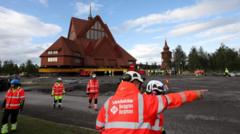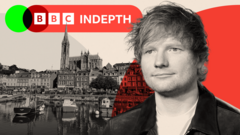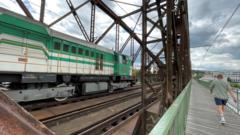As the air-conditioned bus weaves through the bustling traffic of the eastern Indian city of Kolkata, tour leader Sujoy Sen lists the many sights on the itinerary.
It sounds like a snapshot of the city's cosmopolitan history – colonial buildings like the General Post Office and the former British viceroy's mansion, Hindu and Jain temples, Greek Orthodox and Portuguese churches, an Anglican cathedral, the homes of freedom fighters who fought the British Raj and Indian merchants who prospered under it.
But unlike most heritage tours, this one happens after sundown. And its main focus is not just the history or architecture but the lights illuminating the buildings.
Kolkata Illumination Project is the latest addition to the city's many heritage tours and walks. Mr. Sen, who runs a tour company, chanced upon a newspaper article about city enthusiasts lighting up some of the city's grand but often neglected heritage buildings. He obtained a list of buildings and went to check them out.
I was stunned, he says. I have seen Paris by night. I didn't realise Kolkata could be like that also. I wanted other people to see it as well.
Himanjali Sankar, born and raised in Kolkata, now living in Delhi, joined the tour. She says the buildings themselves are familiar to her but the illumination changes them. It is like they are coming alive, reclaiming their grandeur.
The project is the brainchild of a citizens' group called Kolkata Restorers.
But it's not a real organization. There is no committee, no president. It's just a label. A WhatsApp group, says Mudar Patherya, the force behind the endeavor.
He says he didn't start out with plans to light up the city. He came upon an old market crowned with a grand dome and a broken clock that had numerals in Bengali, the language most commonly spoken in the city.
An avowed Kolkata evangelist, he wanted to paint the dome and raised the money for it from friends and associates. But then I realised while it looked good during the day, in the evening it could not be seen at all, he says. So I again passed the hat around and raised money to illuminate it.
He ended up with some funds left over. So he also lit up a temple tucked away in a storied north Kolkata neighborhood. The temple's intricately carved stone facade came alive in the soft yellow glow of the LED lights in a way it could not in harsh sunlight.
Mr. Patherya was hooked. Within weeks he had lined up the imposing British neoclassical colonial building housing the Geological Survey of India. Soon he got permission to light up one of the city's most famous addresses - Raj Bhavan, the governor's mansion, once the residence of the British viceroy.
In about 21 months we are at about 92 buildings, he says. The model is simple. It's your property, my lights. You only pay for the electricity and I work out that cost in advance.
Getting the light intensity right required trial and error, says lighting designer Suyash Narsaria.
We reduced the wattage to make it more efficient, changed the positions, put lighting in layers to highlight columns, railings and murals.
But as the project expanded, Mr. Patherya realised there was one problem he had not foreseen, beyond squirrels chewing through the wires. The buildings were often in a state of disrepair and the illumination highlighted that.
Luckily, Mr. Patherya found the man who could help him. Swapan Dutta, a fourth-generation clock repairer, traces his lineage back to a great-grandfather who worked as a clock technician for the British-era firm Cooke and Kelvey.
Mr. Dutta, nicknamed 'Ghari-babu', is excited to work on the Hogg Market clock, which he calls the star of Kolkata's tower clocks. It's a clock that chimes every fifteen minutes, a different tune for every quarter hour, a sound the city has not heard in years.
Mr. Patherya wants to show that heritage restoration can be citizen-led and crowdsourced. An apartment in one of the city's poshest complexes can cost about 150 million rupees (around $1.7 million). With just 22 million rupees, we've restored 92 buildings, eight or nine clocks, and some 1,300 tombstone plaques.
Mr. Patherya is not done. On the Kolkata by night tour, he gestures towards almost an entire block lit up by Kolkata Restorers: all imposing red-brick neoclassical buildings closed on a Sunday evening but glowing warmly yellow.
I want to get to 200 buildings, he says. Then it would be one of the most wondrous cities at night in the country. Because the architecture is already there.




















